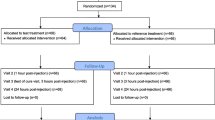Abstract
The efficacy and tolerability of aceclofenac was compared with diclofenac resinate in a double-blind, multicentre randomised study in patients with acute low back pain suffering from degenerative spinal disorders. The study included 227 patients randomised to receive either aceclofenac 2 × 100 mg daily or diclofenac resinate 2 × 75 mg daily for up to 10 days. The primary objective was to demonstrate the clinical non-inferiority of the analgesic efficacy of aceclofenac compared with diclofenac resinate, as assessed by changes from baseline in the visual analogue scale (0–100 mm) pain score, at rest and at visit 3 (final visit on day's 8–10). Secondary objectives included the time to early cure (resolution of pain) and global assessment of tolerability. Mean change in pain score at rest, and as visit 3, compared with baseline, was 61.6 mm (SD 24.5) for the aceclofenac group (n = 100) and 57.3 mm (SD 22.8) for the diclofenac resinate group (n = 105) in the per-protocol population. Similar changes were observed in the intention-to-treat population. Between-group differences of 4.5 mm and 5.5 mm for the per-protocol and intention-to-treat populations, respectively, demonstrated clinical non-inferiority of aceclofenac compared with diclofenac resinate. Furthermore, there was evidence for superiority of aceclofenac over diclofenac resinate in terms of statistical significance, as the one-sided 97.5% confidence interval was above −10 mm and 0 mm. In the intention-to treat population, a total of six aceclofenac-treated patients discontinued their medication owing to early cure, compared with only one patient receiving diclofenac resinate. Seventeen aceclofenac- (14.9%), and 18 diclofenac resinate-treated patients (15.9%) reported at least one adverse event. However, the total number of adverse events reported was lower in patients receiving aceclofenac (22 versus 31 in the diclofenac resinate group). In conclusion, non-inferiority of the analgesic efficacy of aceclofenac compared with diclofenac resinate was demonstrated in patients with localised, uncomplicated acute lumbosacral pain. For the reduction in pain levels from baseline there was also evidence for superiority of aceclofenac compared with diclofenac resinate in terms of statistical significance, although this difference was not considered clinically relevant. The results also showed a trend towards a better safety and tolerability profile of aceclofenac over diclofenac resinate from a clinical point of view.
Similar content being viewed by others
Author information
Authors and Affiliations
Additional information
Received: 28 June 2002 / Accepted: 12 December 2002
Rights and permissions
About this article
Cite this article
Schattenkirchner, M., Milachowski, K. A double-blind, multicentre, randomised clinical trial comparing the efficacy and tolerability of aceclofenac with diclofenac resinate in patients with acute low back pain. Clin Rheumatol 22, 127–135 (2003). https://doi.org/10.1007/s10067-003-0710-9
Issue Date:
DOI: https://doi.org/10.1007/s10067-003-0710-9




